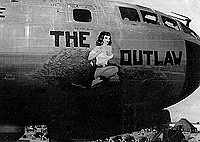Updated7/10/2008
Home Nose Art Master
List Contributors
Units Links
THE CRASH OF THE OUTLAW (2
October, 1951)
19th Bombardment Group, 28th Bombardment Squadron, Kadena AFB, Okinawa

During an earlier combat mission flown by another crew, the 28th Bomb Squadron B-29 dubbed The Outlaw had taken a hit from a Soviet MiG-15 cannon to the left outboard engine. Although the combat-damaged engine had been replaced, several test flights had been aborted because the engine failed its run-up check. Ours would be the last crew to "almost" fly The Outlaw.
With the minimum required six crewmembers, we preflighted, fired up, and taxied
out behind an SB-17 search and rescue version of the famous WW II Flying
Fortress. A light rain began falling as we proceeded through our run up.
Our engines, including the questionable number one, checked out and we were
cleared into takeoff position behind the SB-17.
As the big tail dragger accelerated down the runway and appeared about to
become airborne, the aircraft suddenly veered over the runway embankment into a
ditch.
While waiting for the rescue
equipment to clear the runway, we shut down our engines to conserve fuel. It was lunchtime so I dug a can of
mushroom soup out of my flight bag and placed it on an amplifier box to heat.
Before the soup was warm, however,
we were given clearance to takeoff. We restarted and rechecked the
engines, and my aircraft commander, Don Thompson, said I could make the takeoff
from the co-pilot's position. I took the controls, advanced the throttles,
and we started rolling. At about forty knots the plane began drifting
left. Our Flight Engineer, Jim Sexton, said we were losing power on
number one. Because of our extreme light weight we'd accelerated
very quickly to takeoff speed. Don took control and attempted to wrestle
the beast into the air. When The Outlaw barely broke ground, it began
turning left. Our left gunner
reported flames coming from number one engine. I activated the emergency
alarm bell, alerting the gunners to brace for a crash, and strained with
Don--maximum right aileron and rudder--in a vain attempt to level the airplane.
I can still see the rising terrain
through that big greenhouse nose aligned with a storage tank perched atop a
slight hill.
To avoid hitting the tank and to
prevent cartwheeling from a wing digging in, Don regained directional control
by reducing power on the opposite outboard engine. Unfortunately, this
left us without enough "oomph" to clear the treetops. The left wing
clipped the storage tank and separated just outboard of number one. We
kept going, smashing though the scrubby, sub-tropical forest. My
instrument panel was jarred almost onto my lap and the nose gun mount and
bombsights broke off and were flung back into the cockpit. The nose gear
strut sheared and was driven into the cabin ceiling, tearing Jim Sexton's
sleeve on its way. As we bounced
over a slight rise, the fuselage broke in two, leaving our gunners in the
severed aft section. My can of mushroom soup hit me on the head.
When we finally came to rest in the
thick undergrowth, I attempted to exit my side window escape hatch without
first shedding my parachute. Jim yelled for me to punch the parachute
release, pulled the backpack from my shoulders, and pushed me out the window. After falling to the ground, we shoved
our way through the growth onto a taxi strip where we were almost run over by
emergency vehicles.
Moments later, Don came out reeking
of gasoline. The other three finally showed up, the tail gunner, "Little
Joe" Griffin, limping from his leap to the ground, our only minor injury
(besides the bump on my head).
The really good news was that there'd been no other crew aboard. The bombardier most certainly would've been killed, and dislocated turrets had crushed every other unoccupied crew position. It was a miracle we did not catch fire and there were no serious injuries.
The bad day at Kadena didn't stop there. Although the SB-17 suffered only minor damage to two props and the right wing tip in its crash, it was later destroyed by fire during the defueling process. SB-17 Photos

(Q: Did Jane Russell have her hand
raised before the crash?)
To Learn More About & View More Photos of The Outlaw, go to the Nose Art Section